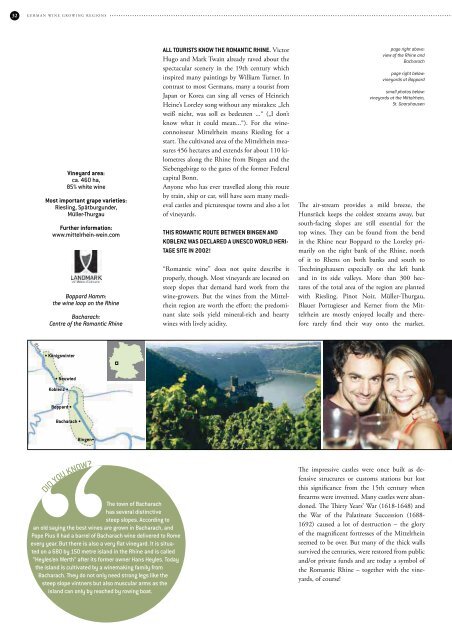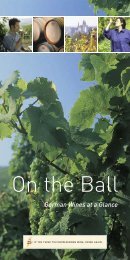the magazine of the german wine institute - Wines of Germany
the magazine of the german wine institute - Wines of Germany
the magazine of the german wine institute - Wines of Germany
You also want an ePaper? Increase the reach of your titles
YUMPU automatically turns print PDFs into web optimized ePapers that Google loves.
32<br />
GERMAN WINE GROWING REGIONS<br />
Rhein<br />
Vineyard area:<br />
ca. 460 ha,<br />
85% white <strong>wine</strong><br />
Most important grape varieties:<br />
Riesling, Spätburgunder,<br />
Müller-Thurgau<br />
Fur<strong>the</strong>r information:<br />
www.mittelrhein-wein.com<br />
Boppard Hamm:<br />
<strong>the</strong> <strong>wine</strong> loop on <strong>the</strong> Rhine<br />
Bacharach:<br />
Centre <strong>of</strong> <strong>the</strong> Romantic Rhine<br />
���������������<br />
���������<br />
���������<br />
���������<br />
�����������<br />
�������<br />
DID YOU KNOW?<br />
The town <strong>of</strong> Bacharach<br />
has several distinctive<br />
steep slopes. According to<br />
an old saying <strong>the</strong> best <strong>wine</strong>s are grown in Bacharach, and<br />
Pope Pius II had a barrel <strong>of</strong> Bacharach <strong>wine</strong> delivered to Rome<br />
every year. But <strong>the</strong>re is also a very flat vineyard. It is situated<br />
on a 680 by 150 metre island in <strong>the</strong> Rhine and is called<br />
“Heyles’en Werth” after its former owner Hans Heyles. Today<br />
<strong>the</strong> island is cultivated by a <strong>wine</strong>making family from<br />
Bacharach. They do not only need strong legs like <strong>the</strong><br />
steep slope vintners but also muscular arms as <strong>the</strong><br />
island can only by reached by rowing boat.<br />
ALL TOURISTS KNOW THE ROMANTIC RHINE. Victor<br />
Hugo and Mark Twain already raved about <strong>the</strong><br />
spectacular scenery in <strong>the</strong> 19th century which<br />
inspired many paintings by William Turner. In<br />
contrast to most Germans, many a tourist from<br />
Japan or Korea can sing all verses <strong>of</strong> Heinrich<br />
Heine’s Loreley song without any mistakes: „Ich<br />
weiß nicht, was soll es bedeuten ...“ („I don’t<br />
know what it could mean...“). For <strong>the</strong> <strong>wine</strong>connoisseur<br />
Mittelrhein means Riesling for a<br />
start. The cultivated area <strong>of</strong> <strong>the</strong> Mittelrhein measures<br />
456 hectares and extends for about 110 kilometres<br />
along <strong>the</strong> Rhine from Bingen and <strong>the</strong><br />
Siebengebirge to <strong>the</strong> gates <strong>of</strong> <strong>the</strong> former Federal<br />
capital Bonn.<br />
Anyone who has ever travelled along this route<br />
by train, ship or car, will have seen many medieval<br />
castles and picturesque towns and also a lot<br />
<strong>of</strong> vineyards.<br />
THIS ROMANTIC ROUTE BETWEEN BINGEN AND<br />
KOBLENZ WAS DECLARED A UNESCO WORLD HERI-<br />
TAGE SITE IN 2002!<br />
“Romantic <strong>wine</strong>” does not quite describe it<br />
properly, though. Most vineyards are located on<br />
steep slopes that demand hard work from <strong>the</strong><br />
<strong>wine</strong>-growers. But <strong>the</strong> <strong>wine</strong>s from <strong>the</strong> Mittelrhein<br />
region are worth <strong>the</strong> effort: <strong>the</strong> predominant<br />
slate soils yield mineral-rich and hearty<br />
<strong>wine</strong>s with lively acidity.<br />
page right above:<br />
view <strong>of</strong> <strong>the</strong> Rhine and<br />
Bacharach<br />
page right below:<br />
vineyards at Boppard<br />
small photos below:<br />
vineyards at <strong>the</strong> Mittelrhein,<br />
St. Goarshausen<br />
The air-stream provides a mild breeze, <strong>the</strong><br />
Hunsrück keeps <strong>the</strong> coldest streams away, but<br />
south-facing slopes are still essential for <strong>the</strong><br />
top <strong>wine</strong>s. They can be found from <strong>the</strong> bend<br />
in <strong>the</strong> Rhine near Boppard to <strong>the</strong> Loreley primarily<br />
on <strong>the</strong> right bank <strong>of</strong> <strong>the</strong> Rhine, north<br />
<strong>of</strong> it to Rhens on both banks and south to<br />
Trechtingshausen especially on <strong>the</strong> left bank<br />
and in its side valleys. More than 300 hectares<br />
<strong>of</strong> <strong>the</strong> total area <strong>of</strong> <strong>the</strong> region are planted<br />
with Riesling. Pinot Noir, Müller-Thurgau,<br />
Blauer Portugieser and Kerner from <strong>the</strong> Mittelrhein<br />
are mostly enjoyed locally and <strong>the</strong>refore<br />
rarely find <strong>the</strong>ir way onto <strong>the</strong> market.<br />
The impressive castles were once built as defensive<br />
structures or customs stations but lost<br />
this significance from <strong>the</strong> 15th century when<br />
firearms were invented. Many castles were abandoned.<br />
The Thirty Years’ War (1618-1648) and<br />
<strong>the</strong> War <strong>of</strong> <strong>the</strong> Palatinate Succession (1688-<br />
1692) caused a lot <strong>of</strong> destruction – <strong>the</strong> glory<br />
<strong>of</strong> <strong>the</strong> magnificent fortresses <strong>of</strong> <strong>the</strong> Mittelrhein<br />
seemed to be over. But many <strong>of</strong> <strong>the</strong> thick walls<br />
survived <strong>the</strong> centuries, were restored from public<br />
and/or private funds and are today a symbol <strong>of</strong><br />
<strong>the</strong> Romantic Rhine – toge<strong>the</strong>r with <strong>the</strong> vineyards,<br />
<strong>of</strong> course!



